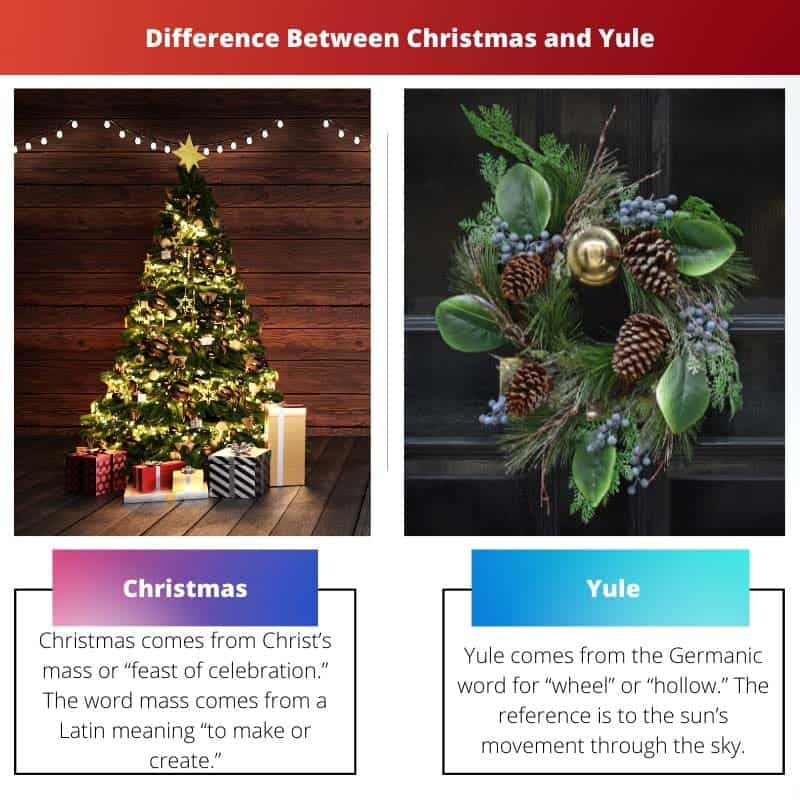The two words Christmas and Yule are used interchangeably in English when referring to celebrating the birth of Jesus Christ. But what exactly is the difference between Christmas and Yule?
Even though both refer to the Christian holiday, there are a few differences between them. In this post, we will see what these differences are.
Key Takeaways
- Christmas is a Christian holiday celebrating the birth of Jesus Christ, while Yule is a pagan festival that marks the winter solstice.
- Christmas traditions include attending church services, exchanging gifts, and decorating trees, whereas Yule traditions involve lighting a Yule log, feasting, and honoring the sun’s return.
- Christmas is celebrated on December 25th, while Yule takes place around December 21st, depending on the exact date of the winter solstice.
Christmas vs Yule
Christmas is a Christian holiday, rooted in the Christian faith, celebrated on December 25th to commemorate the birth of Jesus Christ. Yule is a pagan festival that marks the winter solstice around December 21st, it has its roots in pre-Christian pagan traditions and has a more mystical focus.

Yule celebrations were originally very important to northern peoples who depended on the sun as their primary source of warmth and light.
Northern Europeans celebrated Yule to honor their gods and goddesses of fertility, who ended winter and ensured that spring would come again.
Christmas Day is a public holiday in many countries throughout the world; it is observed religiously by the majority of Christians and culturally by many non-Christians, and it is an important element of the holiday season.
Christmas Day is observed on December 25, however, this date has not always been consistent with the present Gregorian calendar.
Comparison Table
| Parameter | Christmas | Yule |
|---|---|---|
| Meaning | Christmas comes from Christ’s mass or “feast of celebration.” The word mass comes from a Latin meaning “to make or create.” | Yule comes from the Germanic word for “wheel” or “hollow.” The reference is to the sun’s movement through the sky. |
| Religion | Christmas is celebrated primarily by Christians who believe in Jesus Christ. | Yule is celebrated by pagans who want to pay homage to Norse gods such as Thor and Odin. |
| Celebration | People exchange gifts with our family and friends, purchase from local merchants, and have trees in our homes. | People exchange gifts with family and friends and purchase from local merchants. Though they don’t have trees in their homes. |
| God | In the Christian tradition, Christmas is a celebration of the birth of Jesus Christ. | Yule is an ancient Germanic midwinter festival associated with the god Odin. |
| Tradition | Popular customs include exchanging gifts, decorating Christmas trees, attending church, sharing meals with family and friend | One tradition associated with Yule is called the Yule log. The log had to be completely to ensure that all creatures who lived in their homes escaped unharmed. |
What is Christmas?
Christmas is a festival that celebrates the birth of Jesus Christ. It is also a holiday celebrated by people around the world in many different ways. Christmas is celebrated on December 25.
This is the day of the year when most countries celebrate Christmas. Different countries and communities celebrate Christmas at other times on December 25.
Many Western cultures celebrate Christmas at sundown or at midnight. However, some Eastern countries, such as China, celebrate Christmas during daylight hours in the late afternoon or early evening.
People celebrate Christmas in several ways with family, friends, and co-workers.
Some people may decorate their homes with Christmas lights, wreaths, and other decorations to give them a festive atmosphere for the holiday season. Some people enjoy giving and receiving gifts during this time of year.
Grants are given to family and friends to show your love and appreciation for them during this special time of year.

What is Yule?
The Yule season is a pagan holiday that has been celebrated in one form or another for thousands of years. Most people think it is a winter solstice celebration because it is the shortest day and the longest night of the year.
But there are no records that anyone ever celebrated the solstice until after Christian missionaries came to Scandinavia in the seventh century A.D.
And if you read early accounts of how they celebrated Yule, it doesn’t sound much like today’s celebrations at all.
The Anglo-Saxons were pagans until they converted to Christianity in the 7th century (the first was King Edwin in 627). However, they didn’t give up their old traditions and beliefs overnight.
Instead, they blended them with new Christian practices and ideas until they became something new.
This period when English people were both Christian and pagan is called The Conversion Period and lasted until 1066 when Christianity became fully established under William the Conqueror.
Yule is an ancient celebration, and many of its traditions are thousands of years old. It is a time for family, feasting, exchanging gifts, and enjoying being together.
The evergreen tree represents life amid winter, and the Yule log represents the sun god who gives us light and life in the dark days of winter.

Main Differences Christmas and Yule
- The term “Christmas” is an oddity in the English language. It’s a shortened version of “Christ’s Mass.” The term “Yule” is derived from an Old Norse word that means “wheel” and alludes to the solar wheel that emerges in German mythology around the winter solstice.
- Christmas is an annual festival on December 25th that commemorates the birth of Jesus Christ. Yule is a December pagan celebration. It used to be observed from late December until the beginning of January.
- Most Christians celebrate Christmas, but it is not an official holiday in most countries. In contrast, Yule is a pagan holiday celebrated by the Germanic peoples, particularly the Anglo-Saxons and Germanic tribes.
- There are several ideas as to where the word “Yule” originated. It’s derived from an old Norse phrase that refers to a wheel that represents the sun’s passage across the sky around the winter solstice. The precise roots of Christmas, on the other hand, remain unknown.
- As is customary on Yule Eve, people burn their Yule logs. They also offered food and drink to Odin and Thor. Christmas tradition includes exchanging gifts, decorating Christmas trees, visiting the church, eating meals, and waiting for Santa Claus to arrive.




